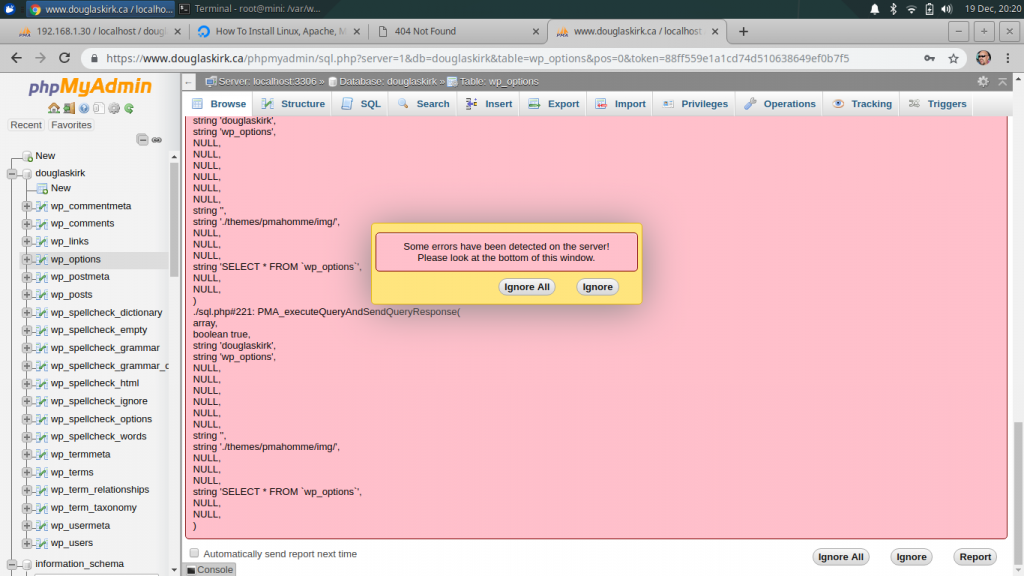My Linux server is hosted on a powerful pink Toshiba Portege M800 that I had purchased it for my wife at Best Buy one Christmas. and it performed well till it’s battery and speed caught up with it.
Now it’s a little Ubuntu 18.04 Server running my two websites and a Minecraft server for my boys.

My Server Notes
My goal in this section is to list a few helpful things I came across.
Please note this is a ongoing scrap page of misc notes. A work in progress.
www.digitalocean.com is a very useful site that I referenced to setup this site with.
The first being:
How To Install WordPress with LAMP on Ubuntu 18.04
https://www.digitalocean.com/community/tutorials/how-to-install-wordpress-with-lamp-on-ubuntu-18-04The second being:
How To Install Linux, Apache, MySQL, PHP (LAMP) stack on Ubuntu 18.04
https://www.digitalocean.com/community/tutorials/how-to-install-linux-apache-mysql-php-lamp-stack-ubuntu-18-04
After creating my site, I soon realised that the last time I did this much work, I didn’t have my database backed up and it was not a good day. What make for an even worst day is when you realise that the backup you protected doesn’t seem to work the way you had thought, and something seems to be missing. With that, I like to do a dry run at rebuilding a mirrored site on another systems and verify everything.
WordPress relies on mysql to deal with it’s database, so another site I came across explained how to create a backup easily.
How To Copy a MySQL Database
http://www.mysqltutorial.org/mysql-copy-database/
I noticed a bunch of errors viewing the wordpress database with phpmyadmin and found a solution at stackoverflow.
https://stackoverflow.com/questions/48001569/phpmyadmin-count-parameter-must-be-an-array-or-an-object-that-implements-co

Note the changes in red.
|| ((count($analyzed_sql_results['select_expr']) == 1)
&& ((count($analyzed_sql_results['select_tables'])) == 1);
|| (count($analyzed_sql_results[‘select_expr’] == 1)
&& count($analyzed_sql_results[‘select_tables’]) == 1;
rockstar@mini:~$
https://www.howtogeek.com/323390/how-to-fix-windows-and-linux-showing-different-times-when-dual-booting/
timedatectl set-local-rtc 1 –adjust-system-clock
https://www.a2hosting.com/kb/installable-applications/optimization-and-configuration/wordpress2/resetting-the-wordpress-administrator-password
UPDATE `wp_users` SET `user_pass` = MD5( ‘PASSWORD’ ) WHERE `wp_users`.`user_login` = “USERNAME”;
https://www.digitalocean.com/community/tutorials/initial-server-setup-with-ubuntu-18-04
Step 5 — Verifying Certbot Auto-Renewal
Let’s Encrypt’s certificates are only valid for ninety days. This is to encourage users to automate their certificate renewal process. The certbot package we installed takes care of this for us by adding a renew script to /etc/cron.d. This script runs twice a day and will automatically renew any certificate that’s within thirty days of expiration.
To test the renewal process, you can do a dry run with certbot:
sudo certbot renew –dry-run
If you see no errors, you’re all set. When necessary, Certbot will renew your certificates and reload Apache to pick up the changes. If the automated renewal process ever fails, Let’s Encrypt will send a message to the email you specified, warning you when your certificate is about to expire.
